Multi-Criteria Analysis of Pollution Caused by Auto Traffic in a Geographical Area Limited to Applicability for an Eco-Economy Environment
Abstract
1. Introduction
“We know the kind of restructuring that is needed. In simplest terms, our fossil-fuel-based, automobile-centered, throwaway economy is not a viable model for the world. The alternative is a solar/hydrogen energy economy, an urban transport system that is centered on advanced-design public rail systems and that relies more on the bicycle and less on the automobile, and a comprehensive reuse/recycle economy.”[1]
- CO carbon monoxide;
- Nitrogen oxides NOx;
- Fine dust PM 10
- Ozone concentration;
- Hydrocarbon emissions;
- Noise;
- Number of vehicles.
- Intersection classification using Synchro software;
- Determining the parameters to be considered for each intersection;
- Calculation of the weight of each pollutant parameter using the AHP method;
- Classification of intersections using the TOPSIS multicriteria method, taking into account the weights of the pollutants obtained in the AHP method.
2. Materials and Methods
- choosing an alternative when using several decisional criteria;
- ordering alternatives, from the best to the least good;
- allocation of resources for several alternatives;
- comparing the processes of an organization with those of the top organizations.
Technique for Order Preference By Similarity to Ideal Solution (TOPSIS) Method
- Type of area;
- Number of lanes;
- Average lane width (m).
- Tilt in the road;
- The existence of right or left right-hand bands;
- The length of storage strips (m);
- Parking activity is appreciated by the number of input and output maneuvers for parking the car.
- Traffic volume for each direction of movement (standard vehicles/hour);
- Critical volumes (maximum volumes associated with each movement);
- Flow rate of saturation;
- Bus stops in the intersection area;
- Type of arrivals;
- Share of vehicles arriving during the green signal.
- The length of the semaphore cycle;
- Green signal duration;
- Type of intersection control;
- Existence of pedestrian-operated systems;
- Minimum green time for pedestrians;
- Phase diagram.
- V—the total volume of vehicles recorded at that time;
- V15max—maximum volume recorded in the quarter of the hour.
- completing the fields in Synchro Studio 8 modeling software windows with appropriate values [25].
- Number of traffic accidents;
- Vehicle-vehicle and vehicle-pedestrian conflict points;
- High delays at intersection;
- Shaping the queues (number of stationary vehicles) and generating blockages;
- Increasing the service level;
- Big fuel consumption for 100 km; and
- Protection of the environment by assessing the level of pollution.
- the lane width (lowering the bandwidth from normal to 3.5 m to 2.5 m leads to a 15% decrease in traffic volume);
- the existence of parking facilities within the 50 m distance before the stop line at the entrance to an intersection leads to a decrease of 35% in the case of a single lane and by 20% for two lanes and 65 maneuvers parking per hour;
- the presence of heavy traffic with a weight of 5% leads to a decrease of 6%, and for a weight of 10% to a decrease by 15% of the bandwidth considered.
| The Pollutants Considered in This Paper Are: | Legislation/Standards |
| Carbon monoxide | The law that refers to carbon monoxide in Romania is no. 104 of 15 June 2011. The limit value is 10 mg/m3, the limit value for the protection of human health (the maximum daily 8-h mean value) |
| Hydrocarbons (HC) | Low no. 104 of 15 June 2011 |
| NOx | Law no. 278 of 24/10/2013 |
| Noise | Order of the Minister of Health 536/1997, STAS 10009-88—Urban Acoustics. Permissible limits of urban noise level. |
| Ozon | Law no. 278 of 24/10/2013 |
| PM10 | Law no. 278 of 24/10/2013, Directive 2008/50/EC of the European Parliament and of the Council of the European Union of 21 May 2008 |
3. Results and Discussions
- affects the central nervous system;
- weakens the heart rate, thus reducing the volume of blood distributed in the body;
- reduces visual acuity and physical capacity;
- short-term exposure may cause acute fatigue;
- can cause breathing difficulties and chest pain in people with cardiovascular disease;
- causes irritability, migraines, rapid breathing, lack of coordination, nausea, dizziness, confusion;
- reduces concentration.
3.1. NOx Nitrogen Oxides
3.2. Noise
3.3. Ozone
3.4. Particulate Matter (PM10)
| CO [µg/m3] | HC [µg/m3] | NOx [µg/m3] | Noise [dB] | Ozone Concentration[µg/m3] | PM10 [µg/m3] | |
| Weight | 0.18084 | 0.23852 | 0.22728 | 0.1276036 | 0.102803 | 0.13107 |
| Intersection 1 Aral-Milea | 187 | 7 | 16 | 91.36 | 39.14 | 67.87 |
| Inter SemaforuluiPaltinului | 170 | 5 | 23 | 80.56 | 38.22 | 40.33 |
| Intersection 3 Semaforului-U.Militara | 165 | 6 | 19 | 85.3 | 37.97 | 41.27 |
| Intersection 4 IBIS | 187 | 10 | 37 | 78.1 | 40.08 | 43.48 |
| Intersection 5 Turismului-Morilor | 245 | 19 | 49 | 76.3 | 40.33 | 25.06 |
| Intersection 6 Turnisor | 235 | 7 | 21 | 86.32 | 39.88 | 26.89 |
| Sum of squares of each column | 241,313 | 620 | 5357 | 41,485.0956 | 9257.7586 | 11,177.64 |
| Matrix V | ||||||
| Intersection 1 Aral-Milea | 0.068844025 | 0.067056 | 0.049685 | 0.057236524 | 0.041818997 | 0.084141 |
| Intersection 2 SemaforuluiPaltinului | 0.062585477 | 0.047897 | 0.071422 | 0.050470385 | 0.040836026 | 0.049999 |
| Intersection 3 Semaforului-U.Militara | 0.060744728 | 0.057476 | 0.059001 | 0.053439968 | 0.040568914 | 0.051164 |
| Intersection 4 IBIS | 0.068844025 | 0.095794 | 0.114896 | 0.048929209 | 0.042823336 | 0.053904 |
| Intersection 5 Turismului-Morilor | 0.090196717 | 0.182008 | 0.15216 | 0.047801519 | 0.043090448 | 0.031068 |
| Intersection 6 Turnisor | 0.086515219 | 0.067056 | 0.065211 | 0.054078992 | 0.042609647 | 0.033336 |
| A+ | 0.060744728 | 0.047897 | 0.049685 | 0.047801519 | 0.040568914 | 0.031068 |
| A− | 0.090196717 | 0.182008 | 0.15216 | 0.057236524 | 0.043090448 | 0.084141 |
| Positive Ideal Solution | ||||||
| Intersection 1 Aral-Milea | 6.55986E-05 | 3.67E-04 | 0 | 8.90193E-05 | 1.56271E-06 | 2.8172E-03 |
| Intersection 2 SemaforuluiPaltinului | 3.38836E-06 | 0 | 4.7E-4 | 7.12285E-06 | 7.13486E-08 | 3.58E-04 |
| Intersection 3 Semaforului-U.Militara | 0 | 9.18E-05 | 8.68E-05 | 3.17921E-05 | 0 | 4.04E-04 |
| Intersection 4 IBIS | 6.55986E-05 | 2.2942E-03 | 4.253E-03 | 1.27168E-06 | 5.08242E-06 | 5.21E-04 |
| Intersection 5 Turismului-Morilor | 8.67428E-04 | 1.79861E-02 | 1.05011E-02 | 0 | 6.35813E-06 | 0 |
| Intersection 6 Turnisor | 6.641186E-04 | 3.673E-04 | 2.4112E-04 | 3.94067E-05 | 4.16459E-06 | 5.15E-06 |
| Intersection 1 Aral-Milea | 0.057792632 |
| Intersection 2 SemaforuluiPaltinului | 0.029007895 |
| Intersection 3 Semaforului-U.Militara | 0.024782979 |
| Intersection 4 IBIS | 0.08449885 |
| Intersection 5 Turismului-Morilor | 0.171349608 |
| Intersection 6 Turnisor | 0.036345096 |
| Negative Ideal Solution | ||||||
| Intersection 1 Aral-Milea | 4.559374E-04 | 1.32141E-02 | 1.105011E-02 | 0 | 1.61659E-06 | 0 |
| Intersection 2 SemaforuluiPaltinului | 7.6238E-04 | 1.798E-02 | 6.519E-03 | 4.57806E-05 | 5.08242E-06 | 1.166E-03 |
| Intersection 3 Semaforului-U.Militara | 8.6712E-04 | 1.5508E-02 | 8.679E-03 | 1.44138E-05 | 6.35813E-06 | 1.087E-03 |
| Intersection 4 IBIS | 4.5593E-04 | 7.433E-03 | 1.389E-03 | 6.90115E-05 | 7.13486E-08 | 9.14E-04 |
| Intersection 5 Turismului-Morilor | 0 | 0 | 0 | 8.90193E-05 | 0 | 2.817E-03 |
| Intersection 6 Turnisor | 1.35534E-05 | 1.3214E-02 | 7.56E-03 | 9.97001E-06 | 2.3117E-07 | 2.5812E-03 |
| Intersection 1 Aral-Milea | 0.155475792 |
| Intersection 2 SemaforuluiPaltinului | 0.162737014 |
| Intersection 3 Semaforului-U.Militara | 0.161748073 |
| Intersection 4 IBIS | 0.101295549 |
| Intersection 5 Turismului-Morilor | 0.053905193 |
| Intersection 6 Turnisor | 0.152901674 |
4. Conclusions
- Use of fuels with a lower lead content;
- The progressive diminution of the park of highly polluting means of transport;
- Streamlining road traffic at crowded intersections (through the green traffic light, setting unique rolling paths);
- The elaboration and approval of the concept of greening the land near the traffic arteries and the creation of protection screens from the vegetation between the streets and the living spaces;
- Eco-economy was a large multi-element system, and exchanges of material, energy and information existed among various subsystems of the large system. Owing to system complexity, selecting proper factors as far as possible to establish a comprehensive index system was important to eco-economy assessment. According to the representative features of regional eco-environment problems in Sibiu city, including natural conditions, environmental pollution and social economic aspects must be considered. Based on the results, natural environment and human economic activities were the most significant factors affecting eco-economy quality. Nevertheless, pollution was also regarded as sensitive factors to decide the regional eco-economy quality in some particular areas;
- Economic development, the problem of pollution, and the correlation between them and socio-economic variables has lately gained more and more attention among a growing number of ecologists, sociologists, philosophers and increasingly economists. After presenting and analyzing for this paper some of previous research, with some of them quoted here, in this area of pollution transportation and eco-economy, we can further illustrate and conclude the reach of countries that have the most devastating impact on the environment. In those countries and especially in the most developed cities, this model of measurement of pollution in intersection can be applied;
- This research could be applied to other cities for the integrated assessment of ecological environment.
- The use of the two AHP and TOPSIS multi-criteria methods allowed an accurate analysis of the intersections in Sibiu for air pollution, noise, and traffic. Although the AHP methods decompose the main problem into a number of subsystems and allow a relatively large number of comparisons, this is not a disadvantage, because the results that we can offer along with the other multicriteria method represent a significant advantage in determining the decisions that should be taken for the health of humans.
- The two methods allow you to connect to different domains from the initial problem. Taking into account the issue of urban traffic, important conclusions can be drawn impacting on the eco-economy.
- Another advantage is that the study can be applied to other areas around the world. In spite of the cost in terms of the measurements made for this analysis, they should not be considered expensive because they are focused on a solution through eco-economy that may reduce disease and save lives.
- Although in the literature the limited number of criteria can be considered a disadvantage of the AHP method, in the context of the study that we conducted in this paper it has not raised any problems, with the nine criteria being sufficient for the evaluation of the multiple factors considered and for the conclusion.
Author Contributions
Funding
Acknowledgments
Conflicts of Interest
References
- Brown, L.R. The Economy and the Earth: The Option: Restructure or Decline. In Eco-Economy: Building an Economy for the Earth; Earth Policy Institute: Washington, DC, USA, 2001; Chapter 1. [Google Scholar]
- Playtech. Available online: https://playtech.ro/2018/pollution-mortality-deaths-2015 (accessed on 18 June 2018).
- Sinem, D.; Ferhat, B.; Sait, C.S. MCDM analysis of wind energy in Turkey: Decision making based on environmental impact. Environ. Sci. Pollut. Res. 2018, 25, 19753–19766. [Google Scholar]
- Ramanathan, R. A note on the use of the analytic hierarchy process for environmental impact assessment. J. Environ. Manag. 2001, 63, 27–35. [Google Scholar] [CrossRef] [PubMed]
- Tolga, K.; Kahraman, C. An integrated fuzzy AHP–ELECTRE methodology for environmental impact assessment. Expert Syst. Appl. 2011, 38, 8553–8562. [Google Scholar] [CrossRef]
- Ren, J.; Liang, H. Multi-criteria group decision-making based sustainability measurement of wastewater treatment processes. Environ. Impact Assess. Rev. 2017, 65, 91–99. [Google Scholar] [CrossRef]
- Ouyang, X.; Guo, F. Intuitionistic fuzzy analytical hierarchical processes for selecting the paradigms of mangroves in municipal wastewater treatment. Chemosphere 2018, 197, 634–642. [Google Scholar] [CrossRef] [PubMed]
- Air Quality Framework Directive 96/62/ECof the European Parliament and the Council. Available online: http://ec.europa.eu/environment/air/quality/index.htm (accessed on 9 July 2018).
- Beria, P.; Maltese, I.; Mariotti, I. Comparing Cost Benefit and Multi-Criteria Analysis: The Evaluation of Neighbourhoods Sustainable Mobility. Available online: http://ww2.unime.it/sefisast/SEFISAST/Conference_Paper_files/BERIA_MALTESE_MARIOTTI.pdf (accessed on 19 August 2018).
- Wang, J.J.; Jing, Y.-Y.; Zhang, C.-F.; Zhao, J.-H. Review on multi-criteria decision analysis aid in sustainable energy decision-making. Renew. Sustain. Energy Rev. 2009, 13, 2263–2278. [Google Scholar] [CrossRef]
- Misra, S.K.; Ray, A. Comparative study on different multi-criteria decision making tools in software project selection scenario. Int. J. Adv. Res. Comput. Sci. 2012, 3. [Google Scholar] [CrossRef]
- Caterino, N.; Iervolino, I.; Manfredi, G.; Cosenza, E. Applicability and effectivenessof different decision making methods for seismic upgrading building structures. In Proceedings of the XIII Convegno Nazionale L’Ingegneria Sismica, Bologna, Italy, 28 June–2 July 2009. [Google Scholar]
- Wang, M.; Liu, S.; Wang, S.; Lai, K.K. A weighted product method for bidding strategies in multi-attribute auctions. J. Syst. Sci. Complex. 2010, 23, 194–208. [Google Scholar] [CrossRef]
- Chang, Y.H.; Yeh, C.H. Evaluating airline competitiveness using multiattribute decision making. Omega 2001, 29, 405–415. [Google Scholar] [CrossRef]
- Saaty, T.L. The Analytic Network Process; RWS Publications: Pittsburgh, PA, USA, 2001. [Google Scholar]
- Saaty, T.L. What is the Analytic Hierarchy Process? In Mathematical Models for Decision Support; NATO ASI Series; Springer: Berlin/Heidelberg, Germany, 1988; Volume 48, pp. 109–121. [Google Scholar]
- Govindan, K.; Jepsen, M.B. ELECTRE: A comprehensive literature review on methodologies and applications. Eur. J. Oper. Res. 2016, 250, 1–29. [Google Scholar] [CrossRef]
- Buchanan, J.; Sheppard, P.; Vanderpoorten, D. Ranking projects using the ELECTRE method. In Proceedings of the 33rd Annual Conference in Operational Research Society of New Zeeland, Auckland, New Zealand, 30 August–2 September 1998; pp. 42–51. [Google Scholar]
- Hwang, C.L.; Yoon, K. Multiple Attribute Decision Making: Methods and Applications; Springer: New York, NY, USA, 1981. [Google Scholar]
- Boran, F.E.; Genç, S.; Kurt, M.; Akay, D. A multi-criteria intuitionistic fuzzy group decision making for supplier selection with TOPSIS method. Expert Syst. Appl. 2009, 36, 11363–11368. [Google Scholar] [CrossRef]
- Highway Capacity Manual; National Research Council: Ottawa, ON, Canada, 2000; ISBN 0-309-06681-6. Available online: https://sjnavarro.files.wordpress.com/2008/08/highway_capacital_manual.pdf (accessed on 04 September 2018).
- Kijawattanee, U.; Teeratat, A.; Sorawee, W.; Patrachart, K.; Rudjanakanoknad, A.; Chaodit, A. Traffic Data Analysis on Sathorn Road with Synchro Optimization and Traffic Simulation. Eng. J. 2017, 21, 57–67. [Google Scholar] [CrossRef]
- FLOREA, D. ş.a. Managementul traficului rutier; Editura Universităţii “Transilvania din Braşov”: Brașov, Romania, 1998; ISBN 973-98-512-7-43. [Google Scholar]
- FLOREA, D. Sisteme Avansate de Transport Rutier; Editura Universităţii “Transilvania” din Braşov: Brașov, Romania, 2006; ISBN 10-973-635-775-9. [Google Scholar]
- Rajakumara, H.N.; Gowda, R.M.M. Road traffic noise prediction models: A Review. Int. J. Sustain. Dev. Plan. 2008, 3. [Google Scholar] [CrossRef]
- Wikipedia. Available online: https://ro.wikipedia.org/wiki/Poluare_acustic%C4%83 (accessed on 05 September 2018).
- Ziarul Lumina. Available online: http://ziarullumina.ro/ozonul-gazul-cu-doua-fete-40107.html (accessed on 6 September 2018).
- CalitateAer. Available online: http://www.calitateaer.ro/public/assessment-page/pollutants-page/pulbere-suspensie-age/?__locale=ro (accessed on 6 September 2018).
- Dr Office. Available online: http://www.systemlife.ro/pm.php (accessed on 6 September 2018).
- Shih, H.-S.; Shyur, H.-J.; Lee, E.S. An extension of TOPSIS for group decision making. Math. Comput. Model. 2007, 45, 801–813. [Google Scholar] [CrossRef]
- Yandle, B.; Vijayaraghavan, M.; Bhattarai, M. The Environmental Kuznets Curve: A Primer; PERC Research Study 02-1; Property and Environment Research Center: Bozeman, Montana, USA, 2002; Available online: https://www.perc.org/articles/environmental-kuznets-curve (accessed on 7 September 2018).
- UN Documents Gathering a Body of Global Agreements. Available online: http://www.un-documents.net/unchedec.htm (accessed on 7 September 2018).
- Georgescu, N.R. Man and Opera; Expert Publishing House: Bucharest, Romania, 1996; Volume 1, pp. 257–263. [Google Scholar]
- Pohoata, I. Strategii si Politici Europene de Dezvoltare Durabila, Suport Curs. Available online: http://www.cse.uaic.ro/_fisiere/Documentare/Suporturi_curs/II_Strategii_si_politici_europene_de_dezvoltare_durabila.pdf (accessed on 8 September 2018).
- Bran, P. Value Economics; Science Publishing House: Chisinau, Moldova, 1991; p. 87. [Google Scholar]

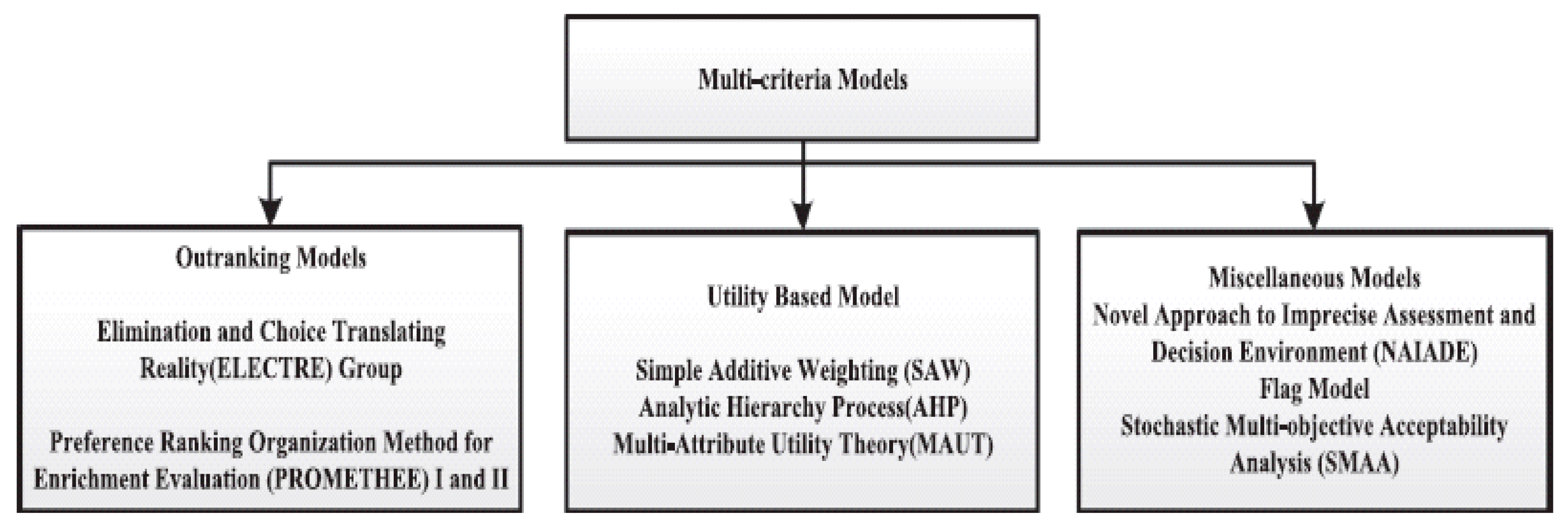
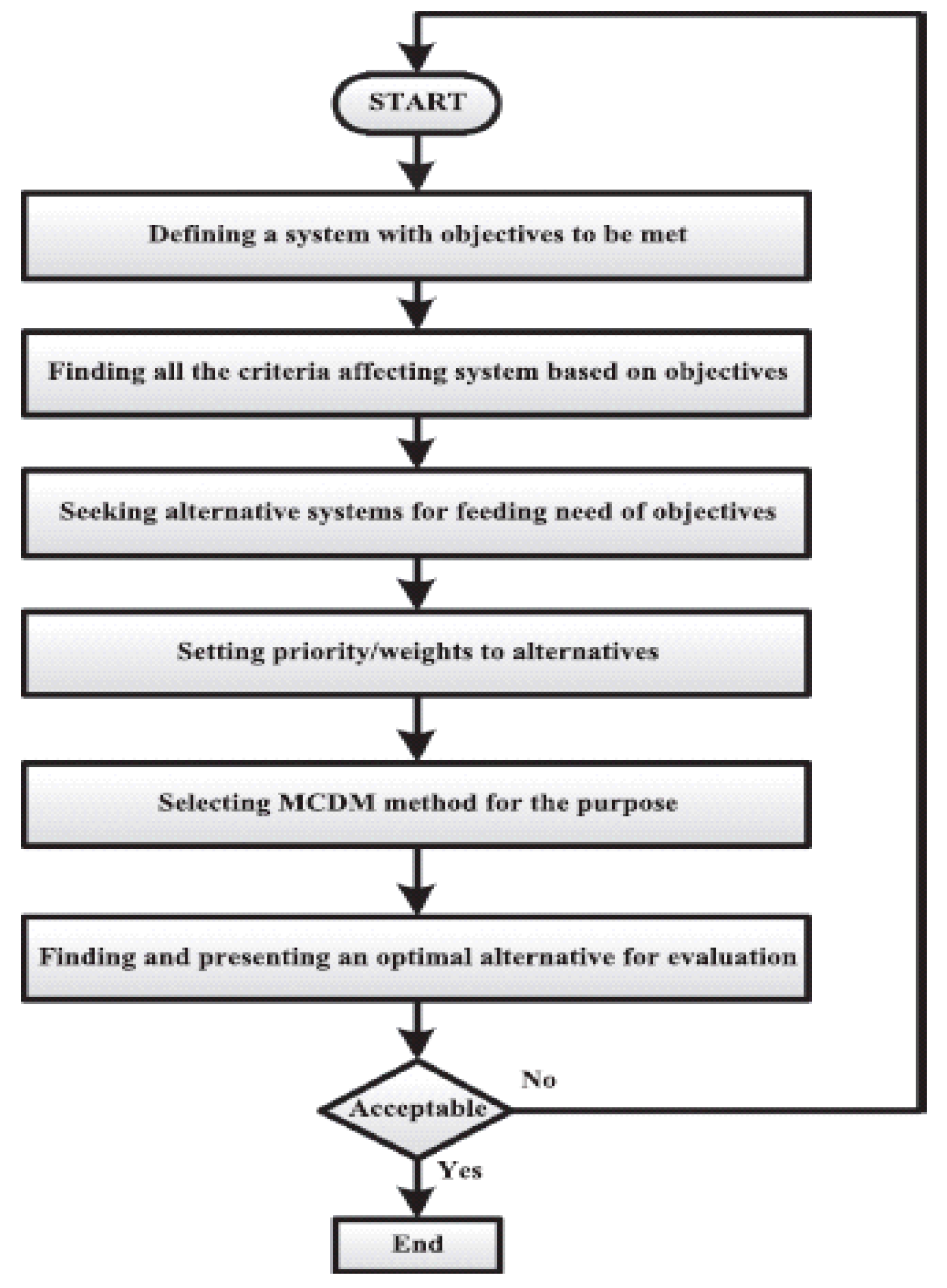
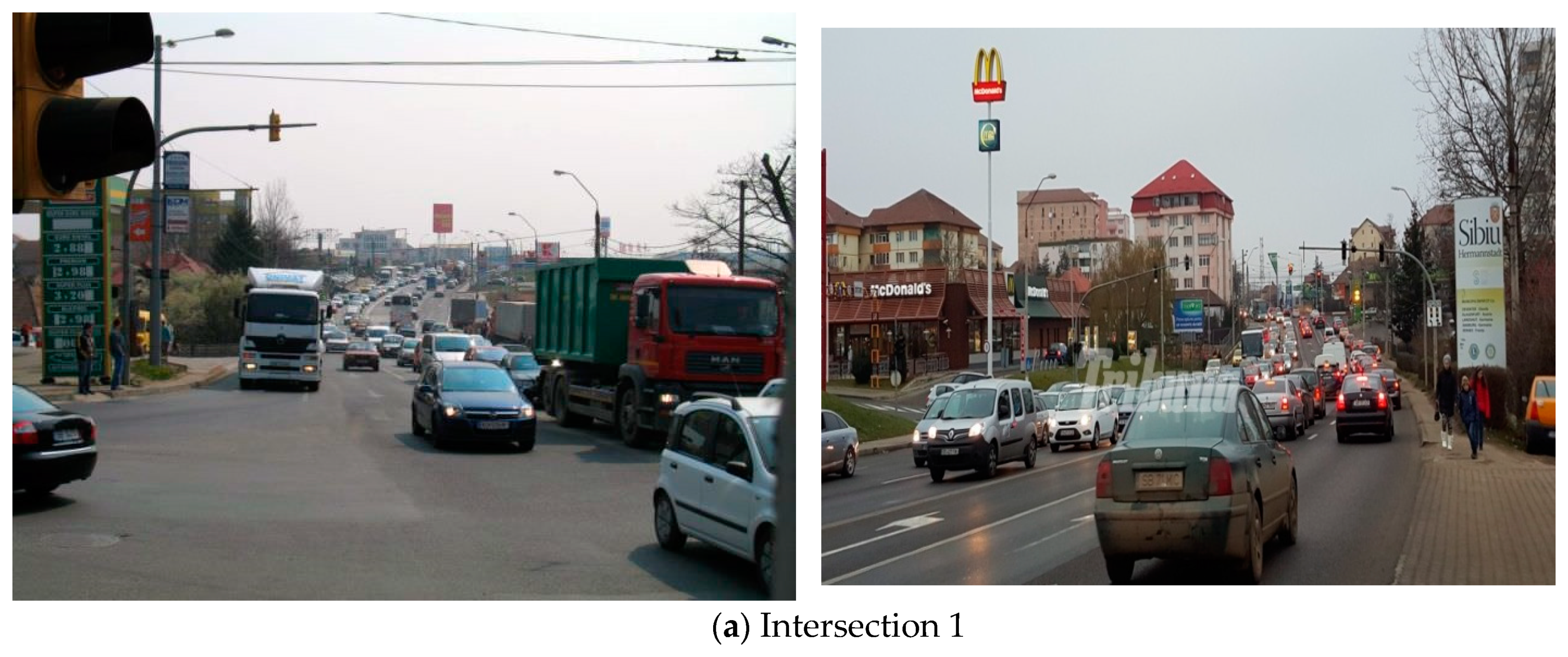
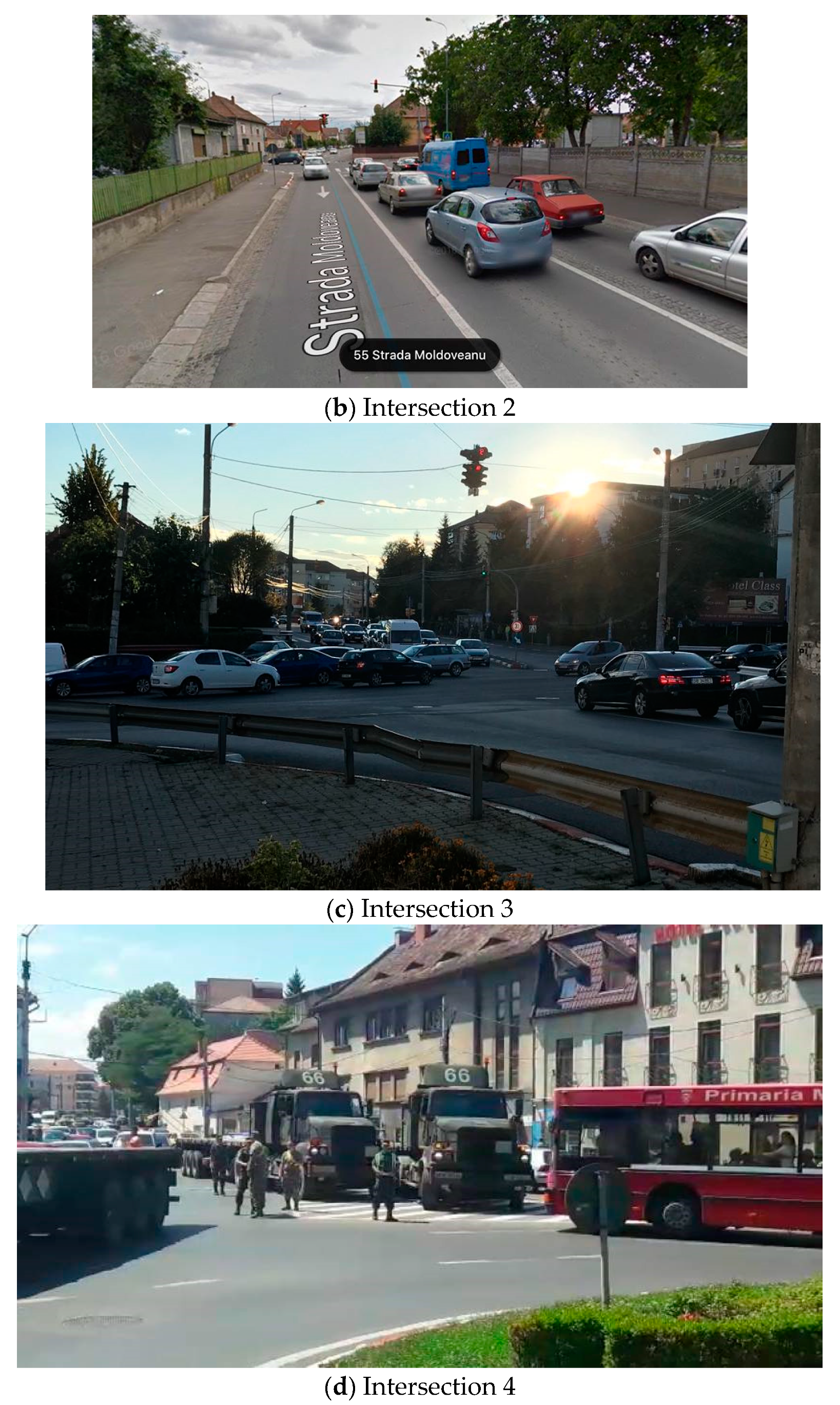
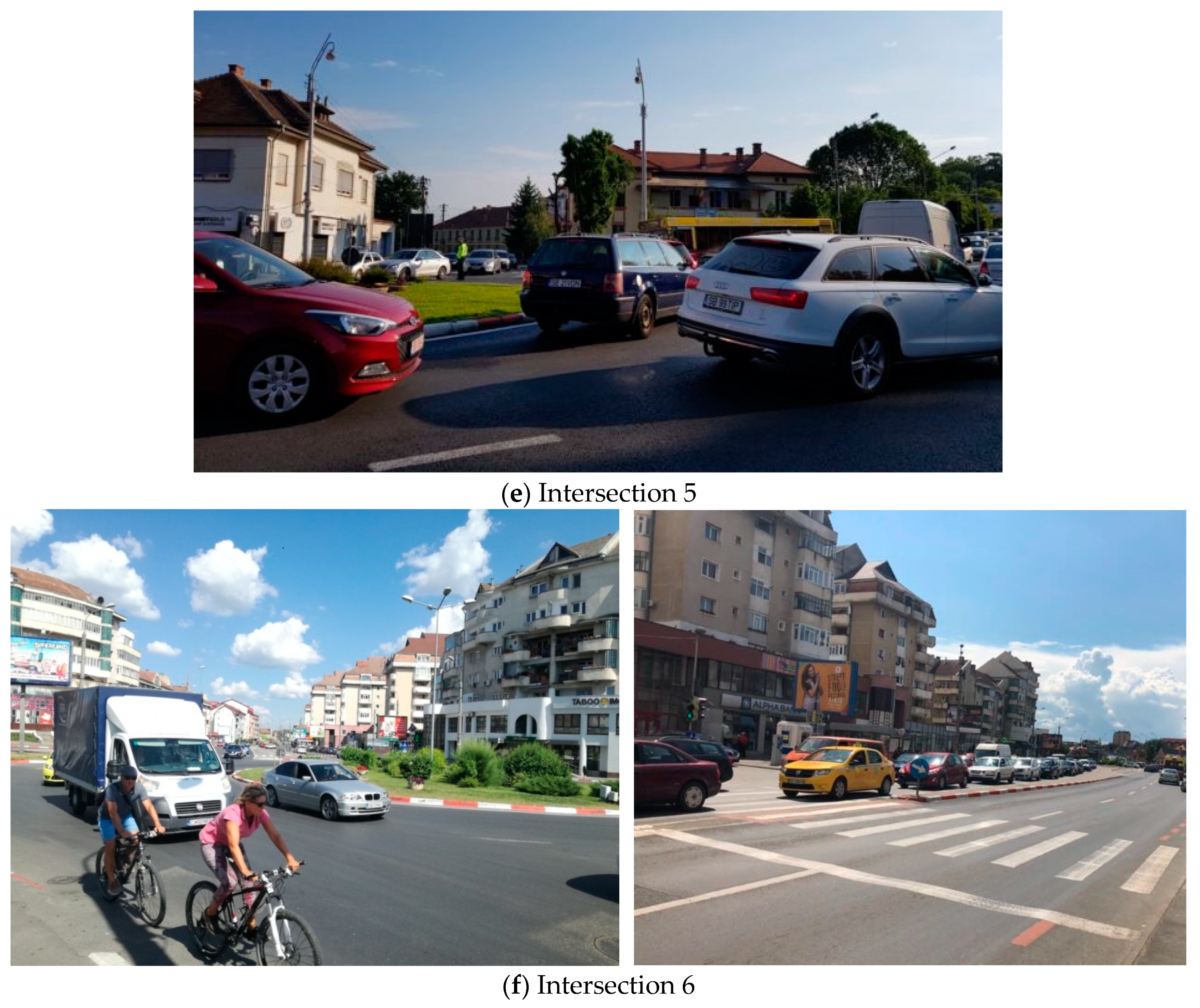
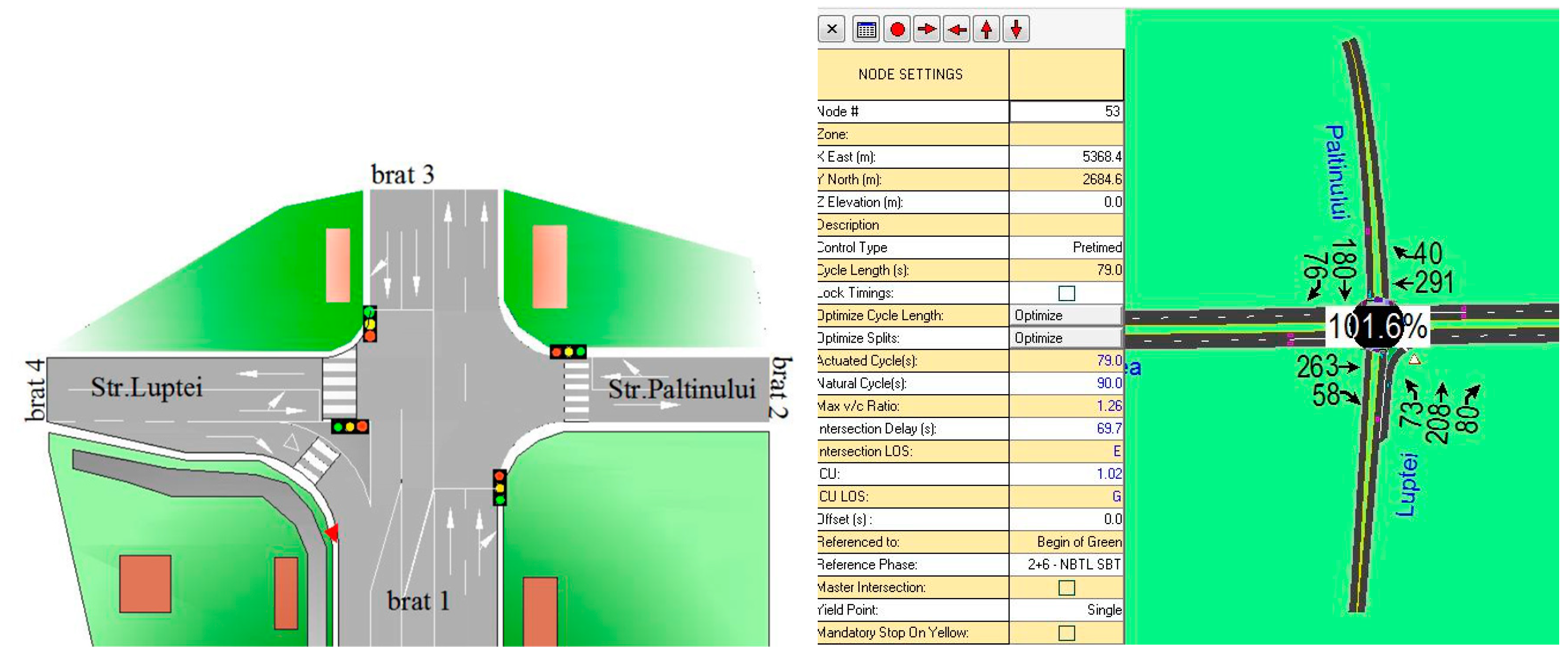
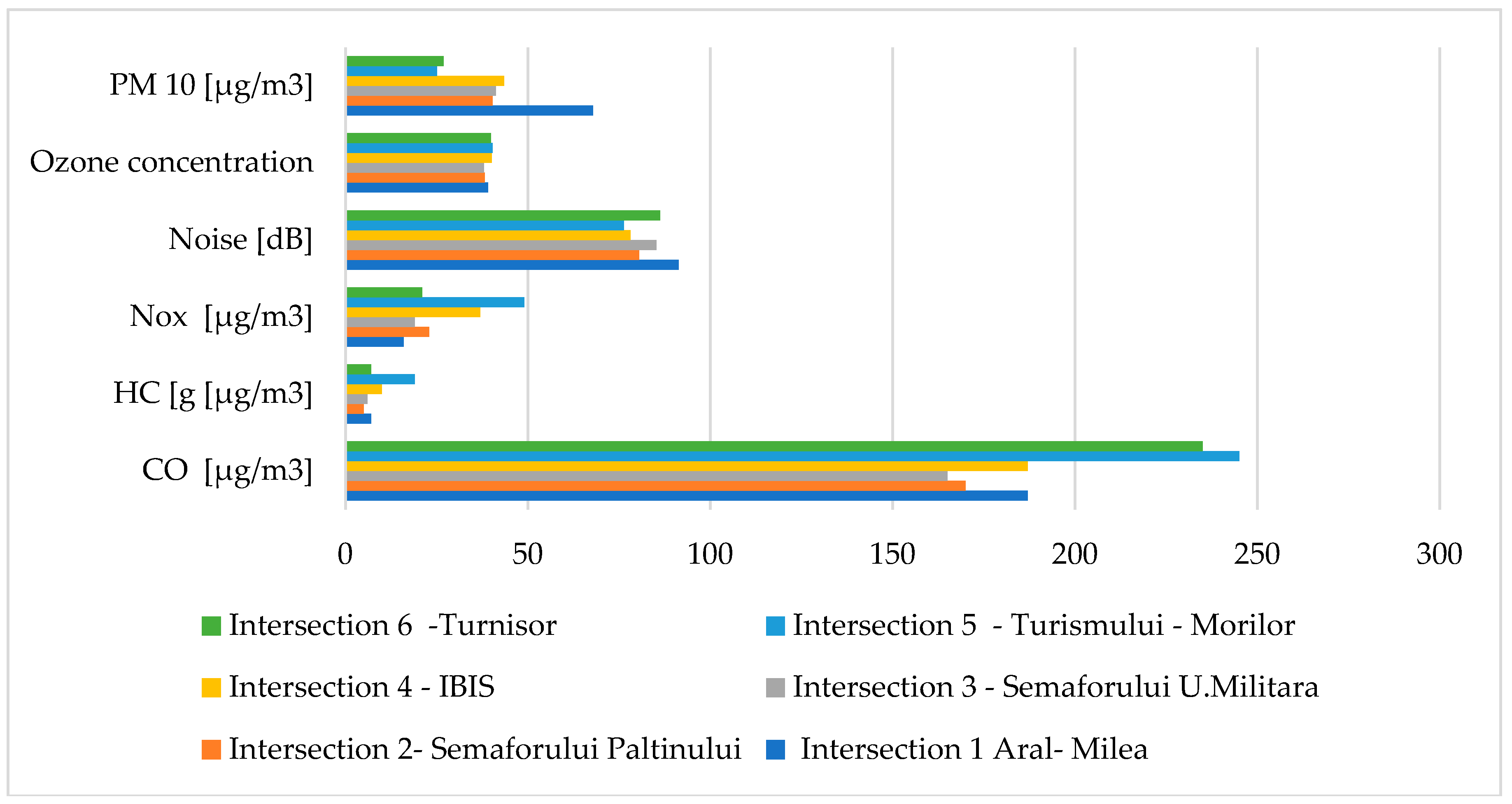

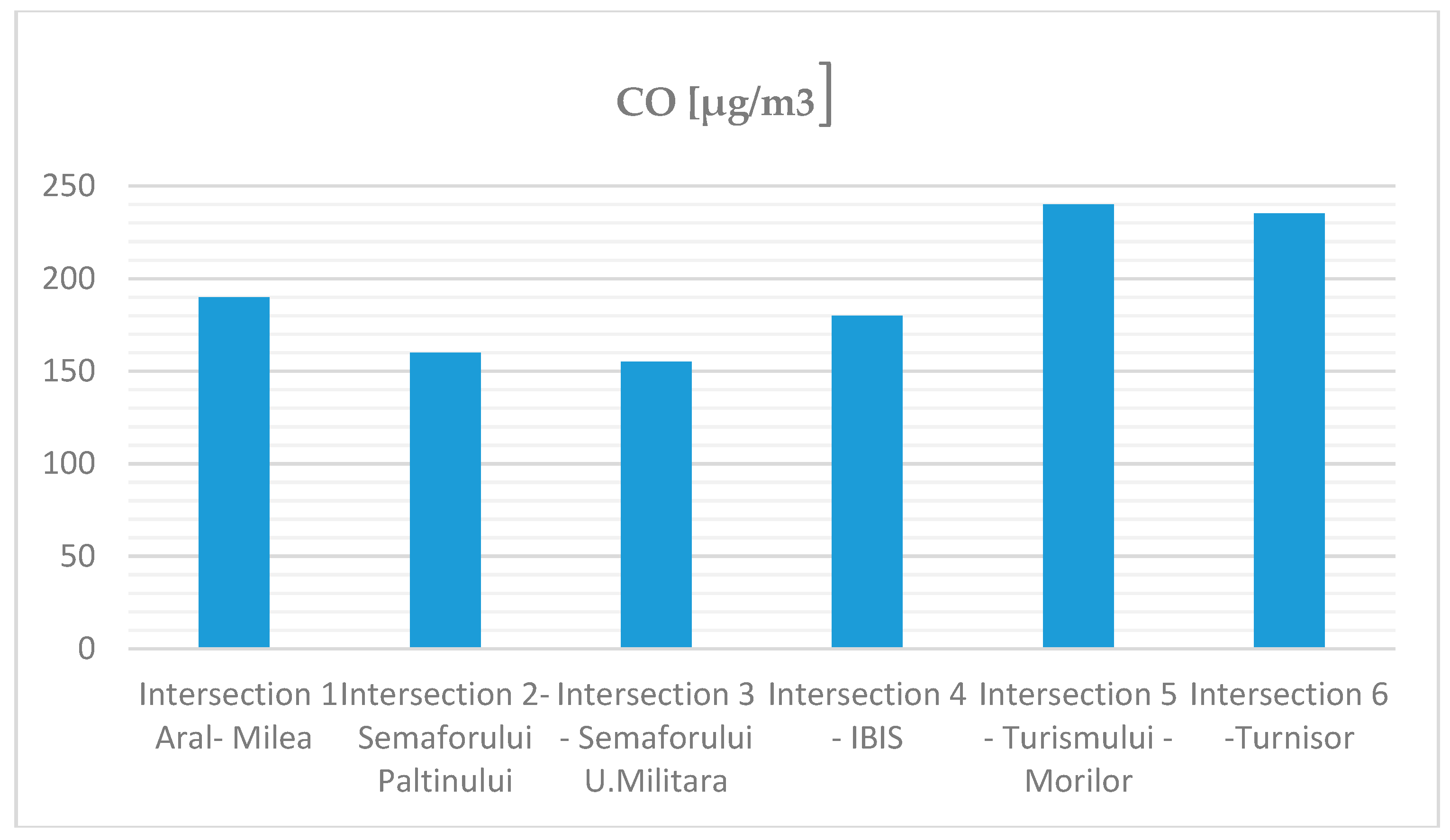
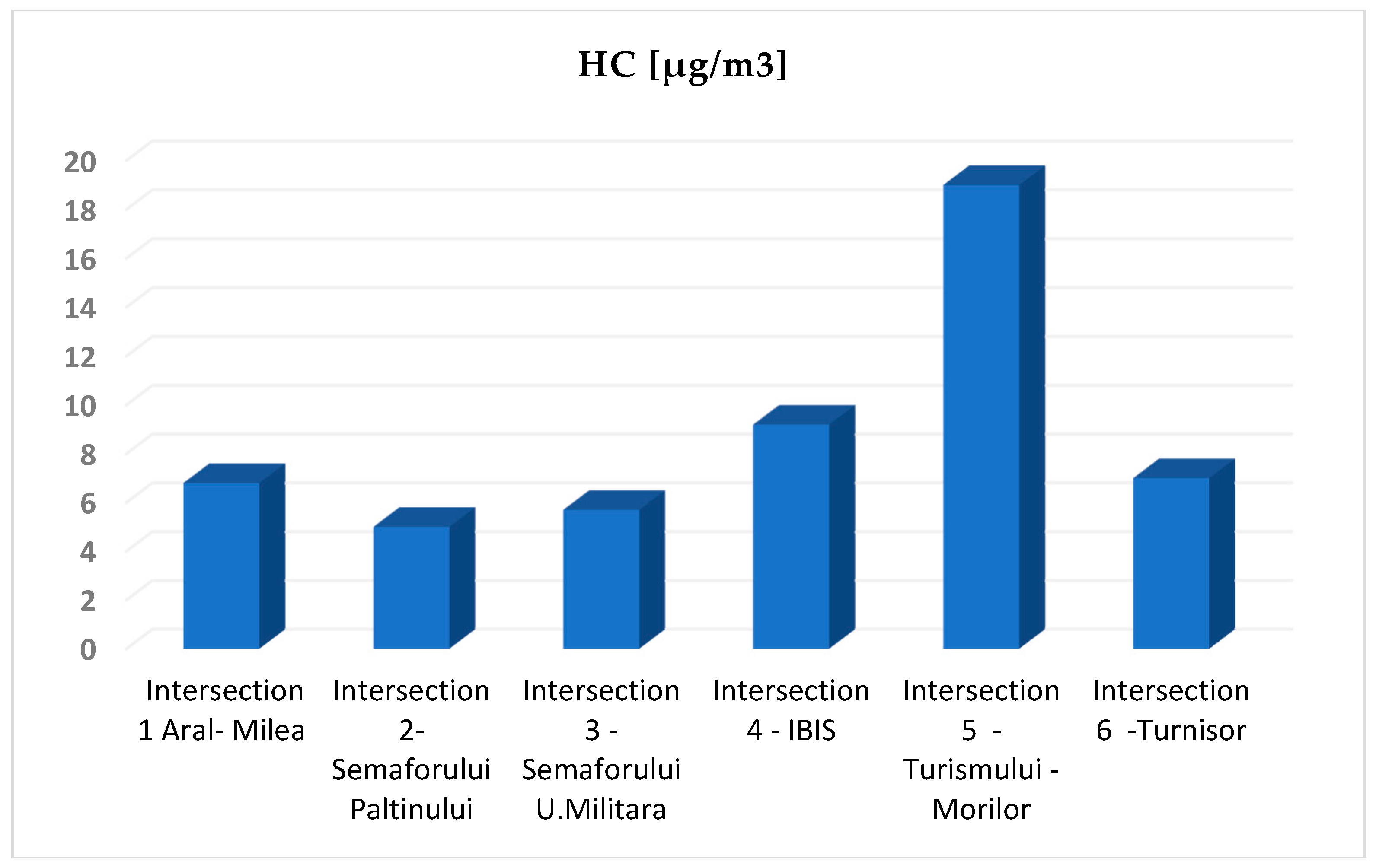
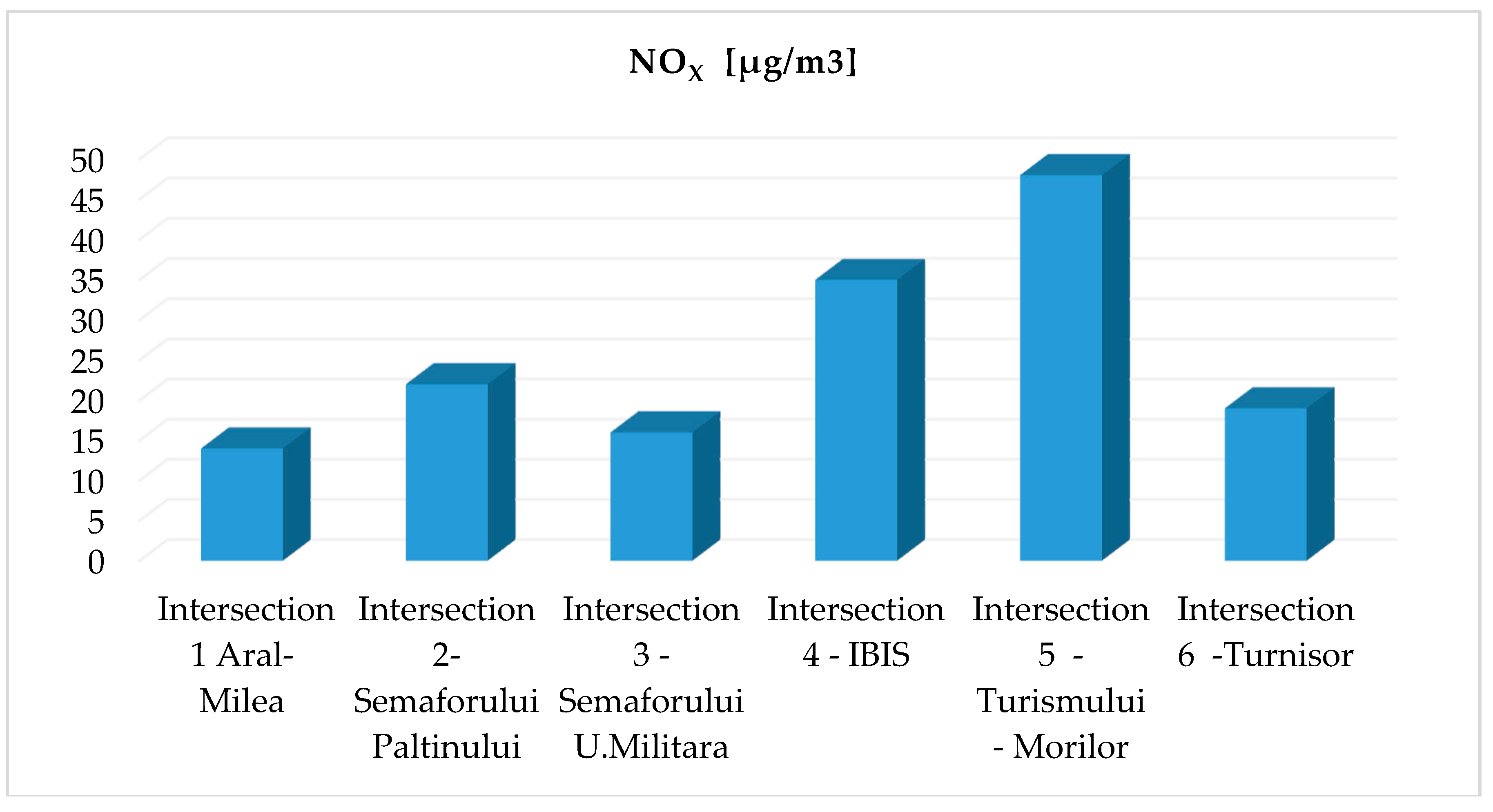
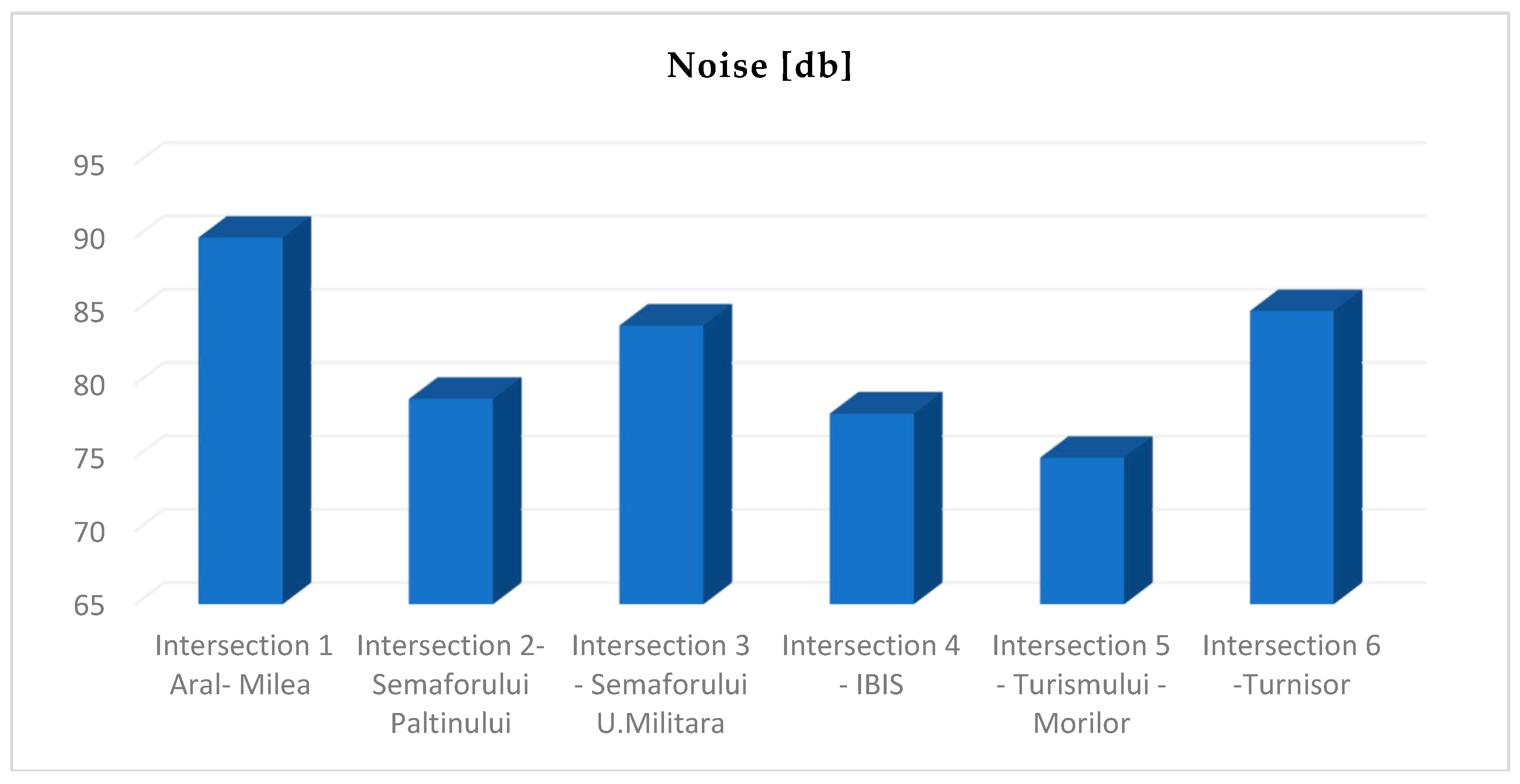
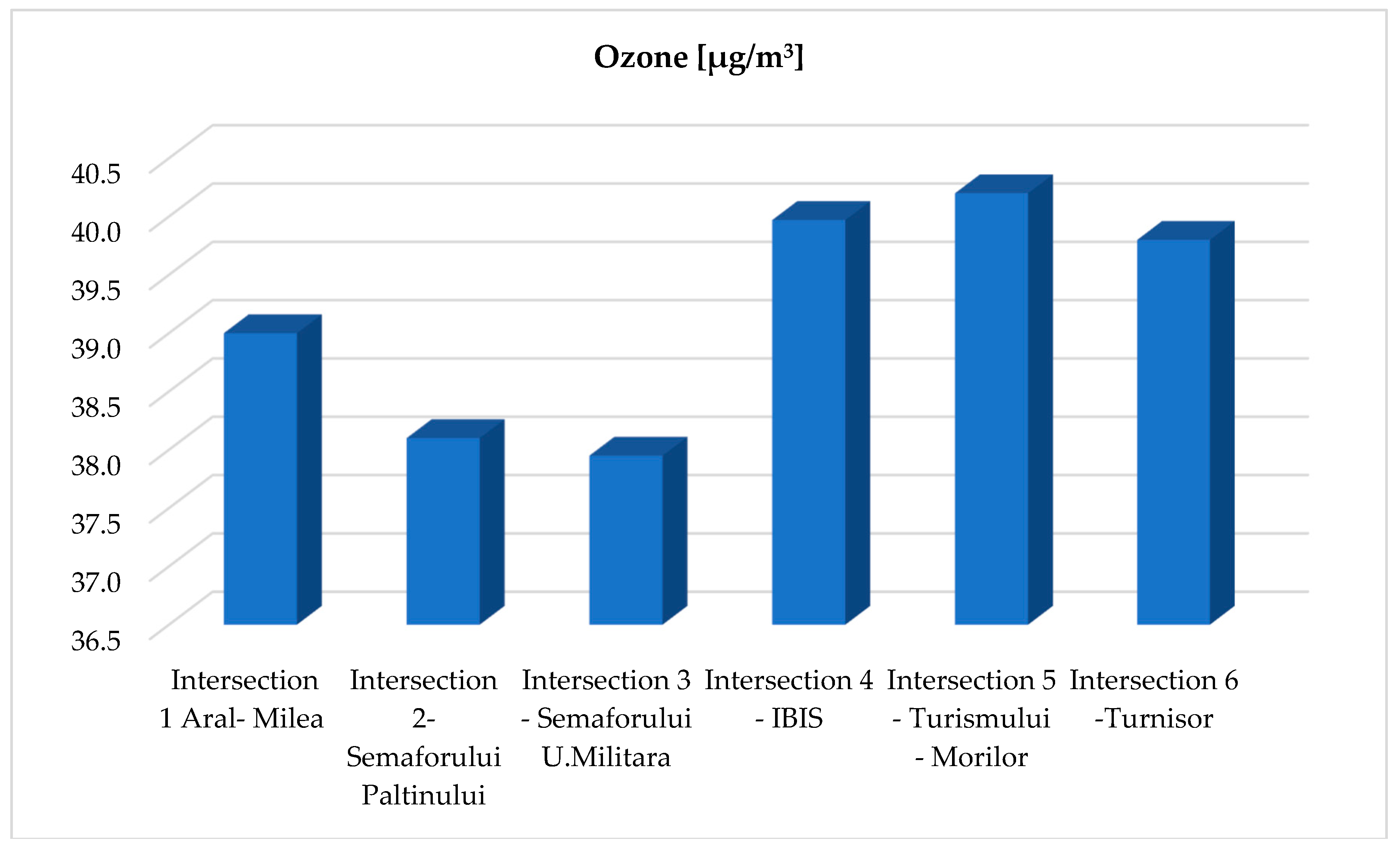
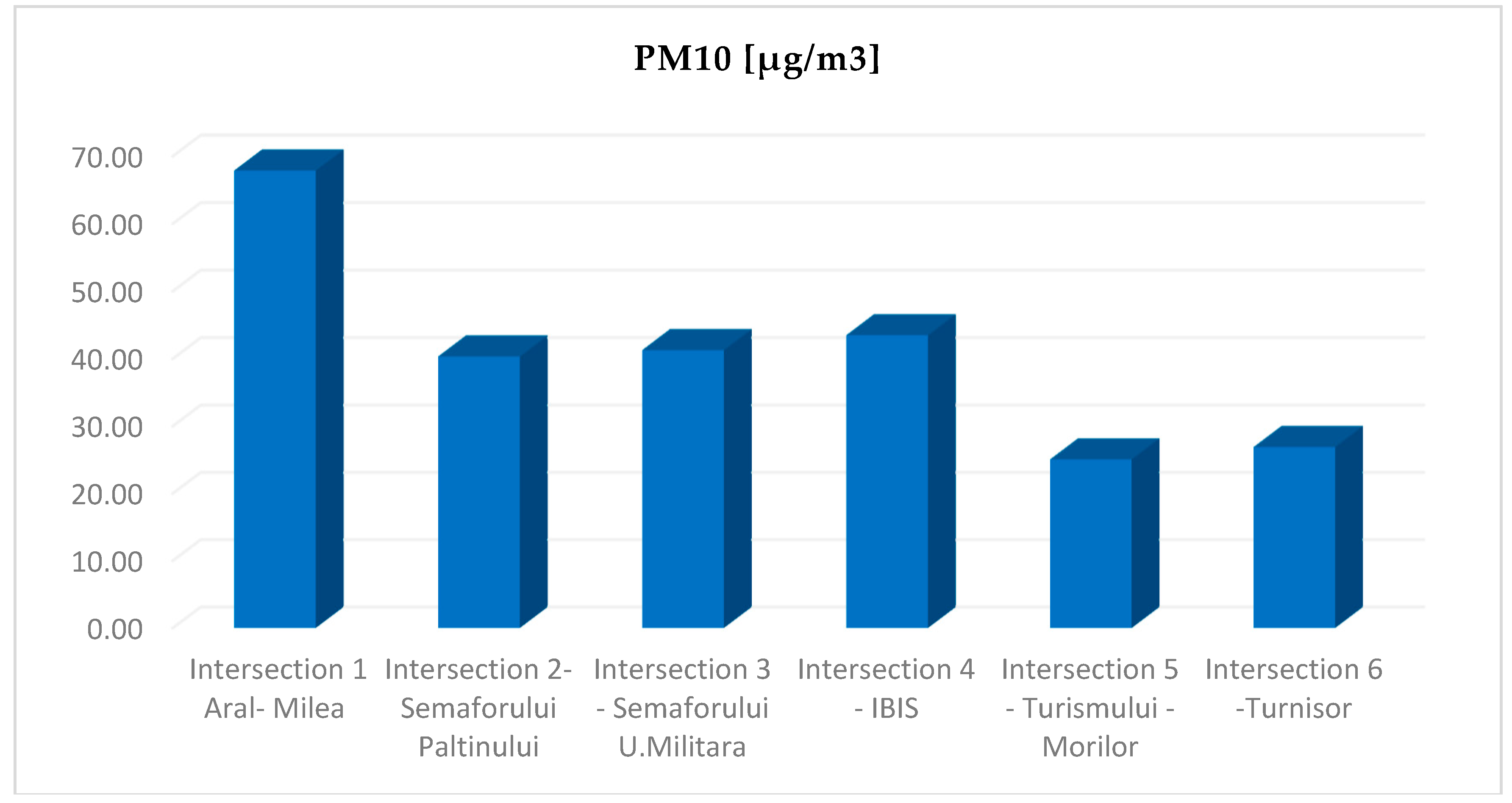

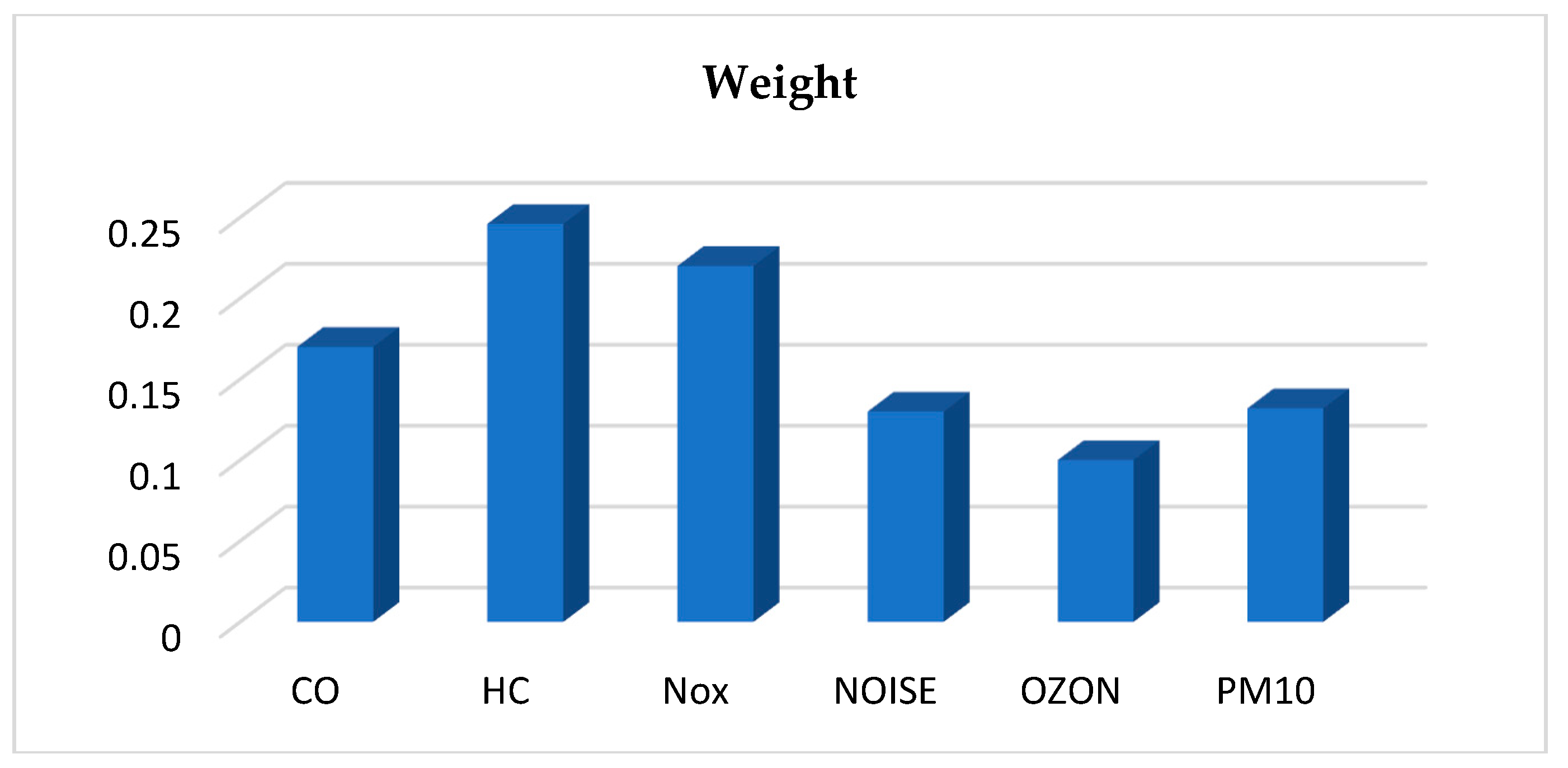
| Method | Area | Steps | Strength | Weakness | References |
|---|---|---|---|---|---|
| Weighted Sum Method | 1. Structural Optimization. 2. Energy Planning | Jweightedsum= w1J1 + w2J2 + …, wmJm Where wi (i = 1, 2, …, m) is a weighing factor for ith objective function and J is a function of designed vector. The best alternative is chosen as max (Jweightedsum). | 1. Simple computation. 2. Suitable for single dimension problem | 1. Only a basic estimate of one’s penchant function 2. Fails to integrate multiple preferences | [11,12,13,14,15,16,17,18] |
| Weighted Product Method | 1. Division of labor in a process based on various elements. 2. Bidding strategies | P = Π [(m)] jMij normal w where Pi is the overall score of the alternative and mij is the normalized value of an attribute. | 1. Labeled to solve decision problems involving criteria of same type. 2. Uses relative values and thus eliminates problem of homogeneity | 1. Leads to undesirable results as it priorities or de-prioritize the alternative which is far from average | [13,14] |
| Analytical Hierarchy Process (AHP) | 1. Resource management 2. Corporate policy and strategy 3. Public policy 4. Traffic and pollution planning 5. Logistics and transportation engineering | 1. Defining objective into a hierarchical model. 2. Determining weights for each criteria. 3. Calculating score of each alternative considering criteria. 4. Calculating overall score of each alternative | 1. Adaptable 2. Does not involve complex mathematics 3. Based on hierarchical structure and thus each criteria can be better focused and transparent | 1.Interdependency between objectives and alternatives leads to hazardous results. 2. Involvement of more decision maker can make the problem more complicate while assigning weights. 3. Demands data collected based on experience | [15,16] |
| Elimination and Choice Translating Reality (ELECTRE) | 1. Energy management 2. Financial management 3. Business management 4. Information technology and communication 5. Logistics and transportation engineering | 1. Based on three pillars: a. Determination of threshold function. b. Concordance index and Discordance index. c. Outranking degree. 2.Assigning rank based on above calculation. | 1. Deals with both quantitative and qualitative features of criteria. 2. Final results are validated withreasons 3. Deals with heterogeneous scales | 1. Less versatile 2. Demands good understanding of objective specially when dealing with quantitative features. | [17,18] |
| Technique for Order Preference by Similarity to Ideal Solutions (TOPSIS) | 1. Logistics 2. Water resource management 3. Energy management 4. Chemical engineering environment and pollution | 1. Calculation of matrices 2. Normalized and decision 3. Calculation of positive and negative ideal solutions 4. Calculation of separation and relative closeness | 1. Works with fundamental ranking 2. Makes full use of allocated information 3. The information need not be independent | 1. Basically works on thebasis of Euclidian distance and so doesn’tconsider any difference between negative andpositive values. 2. The attribute valuesshould be monotonically increasing or decreasing. | [19,20] |
| The Intensity of Importance | Definition |
|---|---|
| 1 | The equal importance of both elements |
| 3 | Less importance of one item than another |
| 5 | Significant or essential importance of one item to another |
| 7 | Demonstrative importance of one item to another |
| 9 | Demonstrative importance of one item to another |
| Method | Number of Uses |
|---|---|
| AHP | 22 |
| Stage-based approach, ranking | 10 |
| Fuzzy approach | 6 |
| ELECTRE | 4 |
| Mathematical programming | 3 |
| Group decision | 3 |
| Traffic Intensity | Peak Hour Factor | Intersection Level of Service | |
|---|---|---|---|
| Intersection 1 Aral-Milea | 1378 | 0.9963 | E |
| Intersection 2—SemaforuluiPaltinului | 1157 | 0.958 | E |
| Intersection 3—SemaforuluiU.Militara | 825 | 0.7265 | D |
| Intersection 4—IBIS | 405 | 0.517 | C |
| Intersection 5—Turismului | 843 | 0.805 | D |
| Intersection 6—Turnisor | 892 | 0.857 | E |
| Average Vehicles for the Day | |
|---|---|
| Intersection 1 Aral-Milea | 2173 |
| Intersection 2—Semaforului Paltinului | 1247 |
| Intersection 3—Semaforului U.Militara | 1649 |
| Intersection 4—IBIS | 810 |
| Intersection 5—Turismului | 675 |
| Intersection 6—Turnisor | 892 |
| CO [µg/m3] | HC [µg/m3] | Nox [µg/m3] | Noise [dB] | Ozone Concentration [µg/m3] | PM10 [µg/m3] | |
|---|---|---|---|---|---|---|
| Intersection 1 Aral-Milea | 187 | 7 | 16 | 91.36 | 39.14 | 67.87 |
| Intersection 2 Semaforului Paltinului | 170 | 5 | 23 | 80.56 | 38.22 | 40.33 |
| Intersection 3 Semaforului-U.Militara | 165 | 6 | 19 | 85.3 | 37.97 | 41.27 |
| Intersection 4 IBIS | 187 | 10 | 37 | 78.1 | 40.08 | 43.48 |
| Intersection 5 Turismului-Morilor | 245 | 19 | 49 | 76.3 | 40.33 | 25.06 |
| Intersection 6 Turnisor | 235 | 7 | 21 | 86.32 | 39.88 | 26.89 |
| Intersection 1 Aral-Milea | Intersection 2 Semaforului Paltinului | Intersection 3 Semaforului-U.Militara | Intersection 4 IBIS | Intersection 5 Turismului-Morilor | Intersection 6 Turnisor | |
|---|---|---|---|---|---|---|
| Intersection 1 Aral-Milea | 1 | 3 | 2 | 4 | 5 | 4 |
| Intersection 2 SemaforuluiPaltinului | 0.333333333 | 1 | 0.5 | 3 | 4 | 3 |
| Intersection 3 Semaforului-U.Militara | 0.5 | 2 | 1 | 4 | 5 | 4 |
| Intersection 4 IBIS | 0.25 | 0.333333333 | 0.25 | 1 | 2 | 1 |
| Intersection 5 Turismului-Morilor | 0.2 | 0.25 | 0.2 | 0.5 | 1 | 0.5 |
| Intersection 6 Turnisor | 0.25 | 0.333333333 | 0.25 | 1 | 2 | 1 |
| Weight Intersections | |
|---|---|
| Intersection 1 Aral-Milea | 0.36006879 |
| Intersection 2 Semaforului Paltinului | 0.17502927 |
| Intersection 3 Semaforului-U.Militara | 0.26339513 |
| Intersection 4 IBIS | 0.07663535 |
| Intersection 5 Turismului-Morilor | 0.04823611 |
| Intersection 6 Turnisor | 0.07663535 |
| CO | Intersection 1 Aral-Milea | Intersection 2 Semaforului Paltinului | Intersection 3 Semaforului-U.Militara | Intersection 4 IBIS | Intersection 5 Turismului-Morilor | Intersection 6 Turnisor |
|---|---|---|---|---|---|---|
| Intersection 1 Aral-Milea | 1 | 0.5 | 0.5 | 1 | 3 | 3 |
| Intersection 2 SemaforuluiPaltinului | 2 | 1 | 1 | 2 | 4 | 4 |
| Intersection 3 Semaforului-U.Militara | 2 | 1 | 1 | 2 | 4 | 4 |
| Intersection 4 IBIS | 1 | 0.5 | 0.5 | 1 | 3 | 3 |
| Intersection 5 Turismului-Morilor | 0.333333333 | 0.25 | 0.25 | 0.333333333 | 1 | 1 |
| Intersection 6 Turnisor | 0.333333333 | 0.25 | 0.25 | 0.333333333 | 1 | 1 |
| HC [µg/m3] | Intersection 1 Aral-Milea | Intersection 2 Semaforului Paltinului | Intersection 3 Semaforului-U.Militara | Intersection 4 IBIS | Intersection 5 Turismului-Morilor | Intersection 6 Turnisor |
|---|---|---|---|---|---|---|
| Intersection 1 Aral-Milea | 1 | 0.5 | 1 | 2 | 4 | 1 |
| Intersection 2 SemaforuluiPaltinului | 2 | 1 | 1 | 3 | 5 | 2 |
| Intersection 3 Semaforului-U.Militara | 1 | 1 | 1 | 2 | 3 | 1 |
| Intersection 4 IBIS | 0.5 | 0.3333 | 0.5 | 1 | 2 | 0.5 |
| Intersection 5 Turismului-Morilor | 0.25 | 0.2 | 0.3333 | 0.5 | 1 | 0.333 |
| Intersection 6 Turnisor | 1 | 0.5 | 1 | 2 | 3 | 1 |
| NOx | Intersection 1 Aral-Milea | Intersection 2 Semaforului Paltinului | Intersection 3 Semaforului-U.Militara | Intersection 4 IBIS | Intersection 5 Turismului-Morilor | Intersection 6 Turnisor |
|---|---|---|---|---|---|---|
| Intersection 1 Aral-Milea | 1 | 2 | 1 | 3 | 4 | 2 |
| Intersection 2 SemaforuluiPaltinului | 0.5 | 1 | 1 | 2 | 3 | 1 |
| Intersection 3 Semaforului-U.Militara | 1 | 1 | 1 | 2 | 3 | 1 |
| Intersection 4 IBIS | 0.3333333 | 0.5 | 0.5 | 1 | 2 | 0.5 |
| Intersection 5 Turismului-Morilor | 0.25 | 0.3333333 | 0.3333333 | 0.5 | 1 | 0.3333333 |
| Intersection 6 Turnisor | 0.5 | 1 | 1 | 1 | 3 | 1 |
| Noise | Intersection 1 Aral-Milea | Intersection 2 Semaforului Paltinului | Intersection 3 Semaforului-U.Militara | Intersection 4 IBIS | Intersection 5 Turismului-Morilor | Intersection 6 Turnisor |
|---|---|---|---|---|---|---|
| Intersection 1 Aral-Milea | 1 | 0.25 | 0.5 | 0.25 | 0.2 | 0.5 |
| Intersection 2 SemaforuluiPaltinului | 4 | 1 | 2 | 1 | 0.5 | 2 |
| Intersection 3 Semaforului-U.Militara | 2 | 0.5 | 1 | 3 | 0.3333333 | 1 |
| Intersection 4 IBIS | 4 | 1 | 2 | 1 | 1 | 2 |
| Intersection 5 Turismului-Morilor | 5 | 2 | 3 | 1 | 1 | 2 |
| Intersection 6 Turnisor | 2 | 0.5 | 1 | 0.5 | 0.5 | 1 |
| Ozone | Intersection 1 Aral-Milea | Intersection 2 Semaforului Paltinului | Intersection 3 Semaforului-U.Militara | Intersection 4 IBIS | Intersection 5 Turismului-Morilor | Intersection 6 Turnisor |
|---|---|---|---|---|---|---|
| Intersection 1 Aral-Milea | 1 | 0.5 | 0.33333 | 2 | 3 | 2 |
| Intersection 2 SemaforuluiPaltinului | 2 | 1 | 0.5 | 2 | 3 | 2 |
| Intersection 3 Semaforului-U.Militara | 3 | 2 | 1 | 3 | 4 | 3 |
| Intersection 4 IBIS | 0.5 | 0.5 | 0.3333333 | 1 | 2 | 1 |
| Intersection 5 Turismului-Morilor | 0.3333333 | 0.3333333 | 0.25 | 0.5 | 1 | 0.5 |
| Intersection 6 Turnisor | 0.5 | 0.25 | 0.3333333 | 1 | 2 | 1 |
| PM10 | Intersection 1 Aral-Milea | Intersection 2 Semaforului Paltinului | Intersection 3 Semaforului-U.Militara | Intersection 4 IBIS | Intersection 5 Turismului-Morilor | Intersection 6 Turnisor |
|---|---|---|---|---|---|---|
| Intersection 1 Aral-Milea | 1 | 0.25 | 0.3333333 | 0.3333333 | 0.142857143 | 0.1666667 |
| Intersection 2 SemaforuluiPaltinului | 4 | 1 | 2 | 3 | 0.3333333 | 0.5 |
| Intersection 3 Semaforului-U.Militara | 3 | 0.5 | 1 | 2 | 0.25 | 0.3333333 |
| Intersection 4 IBIS | 2 | 0.3333333 | 0.5 | 1 | 0.2 | 0.25 |
| Intersection 5 Turismului-Morilor | 7 | 3 | 4 | 5 | 1 | 2 |
| Intersection 6 Turnisor | 6 | 2 | 3 | 4 | 0.5 | 1 |
| CO | HC | Nox | Noise | Ozon Concentration | PM10 | |
|---|---|---|---|---|---|---|
| Intersection 1 Aral-Milea | 0.160119048 | 0.184407669 | 0.289578346 | 0.05137842 | 0.164619883 | 0.036097917 |
| Intersection 2 SemaforuluiPaltinului | 0.278571429 | 0.290681785 | 0.181219149 | 0.191362738 | 0.215629984 | 0.189769821 |
| Intersection 3 Semaforului-U.Militara | 0.278571429 | 0.198733315 | 0.204474963 | 0.161340582 | 0.351222754 | 0.117817562 |
| Intersection 4 IBIS | 0.160119048 | 0.096134652 | 0.099693877 | 0.214947644 | 0.107057416 | 0.068218244 |
| Intersection 5 Turismului-Morilor | 0.061309524 | 0.054894169 | 0.061358375 | 0.273496794 | 0.063503456 | 0.403665814 |
| Intersection 6 Turnisor | 0.061309524 | 0.17514841 | 0.163675289 | 0.107473822 | 0.097966507 | 0.290537084 |
| Pollutant Name | Weight |
|---|---|
| CO | 0.18084854 |
| HC | 0.238524318 |
| NOx | 0.227281735 |
| NOISE | 0.127603682 |
| OZONE | 0.102802982 |
| PM10 | 0.131070247 |
| Intersection Name | Value of TOPSIS | RANK |
|---|---|---|
| Intersection 5 Turismului-Morilor | 0.239307633 | 1 |
| Intersection 4—IBIS | 0.545202384 | 2 |
| Intersection 1 Aral-Milea | 0.729014588 | 3 |
| Intersection 6 Turnisor | 0.807948659 | 4 |
| Intersection 2 Semaforului-Paltinului | 0.848716217 | 5 |
| Intersection 3 Semaforului-U.Militara | 0.867137517 | 6 |
© 2018 by the authors. Licensee MDPI, Basel, Switzerland. This article is an open access article distributed under the terms and conditions of the Creative Commons Attribution (CC BY) license (http://creativecommons.org/licenses/by/4.0/).
Share and Cite
Borza, S.; Inta, M.; Serbu, R.; Marza, B. Multi-Criteria Analysis of Pollution Caused by Auto Traffic in a Geographical Area Limited to Applicability for an Eco-Economy Environment. Sustainability 2018, 10, 4240. https://doi.org/10.3390/su10114240
Borza S, Inta M, Serbu R, Marza B. Multi-Criteria Analysis of Pollution Caused by Auto Traffic in a Geographical Area Limited to Applicability for an Eco-Economy Environment. Sustainability. 2018; 10(11):4240. https://doi.org/10.3390/su10114240
Chicago/Turabian StyleBorza, Sorin, Marinela Inta, Razvan Serbu, and Bogdan Marza. 2018. "Multi-Criteria Analysis of Pollution Caused by Auto Traffic in a Geographical Area Limited to Applicability for an Eco-Economy Environment" Sustainability 10, no. 11: 4240. https://doi.org/10.3390/su10114240
APA StyleBorza, S., Inta, M., Serbu, R., & Marza, B. (2018). Multi-Criteria Analysis of Pollution Caused by Auto Traffic in a Geographical Area Limited to Applicability for an Eco-Economy Environment. Sustainability, 10(11), 4240. https://doi.org/10.3390/su10114240






